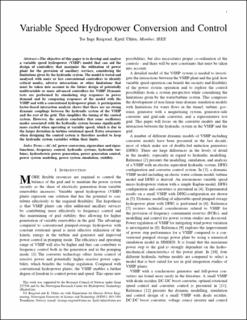| dc.contributor.author | Reigstad, Tor Inge | |
| dc.contributor.author | Uhlen, Kjetil | |
| dc.date.accessioned | 2021-03-10T14:17:12Z | |
| dc.date.available | 2021-03-10T14:17:12Z | |
| dc.date.created | 2020-03-05T11:24:42Z | |
| dc.date.issued | 2020 | |
| dc.identifier.citation | IEEE transactions on energy conversion. 2020, 35 (1), 386-393. | en_US |
| dc.identifier.issn | 0885-8969 | |
| dc.identifier.uri | https://hdl.handle.net/11250/2732684 | |
| dc.description.abstract | The objective of this paper is to develop and analyse a variable speed hydropower (VSHP) model that can aid the design of controllers that maximize the utilization of power plant for the provision of ancillary services, considering the limitations given by the hydraulic system. The model is tested and analysed with more or less conventional controllers to identify critical modes, adverse interactions or other limitations that must be taken into account in the future design of potentially multivariable or more advanced– controllers for VSHP. Dynamic tests are performed by simulating step responses in power demand and by comparing responses of the model with the VSHP and with a conventional hydropower plant. A participation factor-based interaction analysis shows that there are no strong dynamic couplings between the hydraulic system of the VSHP and the rest of the grid. This simplifies the tuning of the control system. However, the analysis concludes that some oscillatory modes associated with the hydraulic system become significantly more excited when operating at variable speed; which is due to the larger deviation in turbine rotational speed. Extra awareness when designing the control system is therefore needed to keep the hydraulic system variables within their limits. | en_US |
| dc.language.iso | eng | en_US |
| dc.publisher | Institute of Electrical and Electronics Engineers (IEEE) | en_US |
| dc.subject | Stability of Power Electronics Systems | en_US |
| dc.subject | Stability of Power Electronics Systems | en_US |
| dc.subject | Hydropower | en_US |
| dc.subject | Hydropower | en_US |
| dc.subject | Power conversion | en_US |
| dc.subject | Power conversion | en_US |
| dc.title | Variable Speed Hydropower Conversion and Control | en_US |
| dc.type | Peer reviewed | en_US |
| dc.type | Journal article | en_US |
| dc.description.version | acceptedVersion | en_US |
| dc.subject.nsi | VDP::Teknologi: 500 | en_US |
| dc.subject.nsi | VDP::Technology: 500 | en_US |
| dc.source.pagenumber | 386-393 | en_US |
| dc.source.volume | 35 | en_US |
| dc.source.journal | IEEE transactions on energy conversion | en_US |
| dc.source.issue | 1 | en_US |
| dc.identifier.doi | 10.1109/TEC.2019.2943233 | |
| dc.identifier.cristin | 1799803 | |
| dc.relation.project | Norges forskningsråd: 257588 | en_US |
| dc.description.localcode | © 2020 IEEE. Personal use of this material is permitted. Permission from IEEE must be obtained for all other uses, in any current or future media, including reprinting/republishing this material for advertising or promotional purposes, creating new collective works, for resale or redistribution to servers or lists, or reuse of any copyrighted component of this work in other works. | en_US |
| cristin.ispublished | true | |
| cristin.fulltext | postprint | |
| cristin.qualitycode | 2 | |
